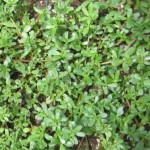Author Archive
Robin Redbreast in Distress
Posted by: | CommentsYesterday my neighbor across the street called me up in the middle of the afternoon.
“You want to see something really bizarre? ” he said. “Well, maybe not bizarre…there’s a Robin caught in the apricot tree, would you come over and help me get her loose? She’s tangled up in some string.”
Of course I went right over after making sure I had a clean, soft cotton handkerchief in my pocket.
At first, I couldn’t see Ms Robin. (Yes, both of us called the Robin ‘she’, so…) Underneath the almost ripe apricots hanging here and there from the bowed branch, a large Robin was hanging with one leg hooked around a small dead twig. At first we thought she was pinned to the tree by the twig, her leg pierced at the joint.She was very quiet at the moment, panting heavily, her chest heaving and her eyes looking as if they were slightly bulging.
Then, detecting a new presence, she started to beat her wings as hard as possible, working herself off of the twig until she hung at another odd angle from the branch. Now I could see the very tiny string, more like a thread really, wound around both of her feet at the ankle, and wound around the small branch of the tree. It must have been a plastic fiber because even though it was very slender, she couldn’t free herself. Although no bigger than a decent sized cobweb strand, it just wouldn’t break no matter how hard she struggled.
Maybe we could lop off the branch and then untangle her? As my neighbor went to find pruners or something, I just kept watching Ms Robin, holding the handkerchief in my hand. I wanted to wrap her up in the cloth so that she would stop struggling. If I could hold her around the wings, then we could see what needed to be done without hurting her.
I started doing a little hummy noise under my breath and focused on carefully moving closer while she was trying to untangle herself. She was almost out of her mind already, so I just wanted to sooth her and calm her down. Suddenly she stopped moving and was hanging directly upside down under the branch.
I reached forward quickly with the handkerchief between my hands and surrounded her terrified little body. Her heart was beating like a trip-hammer, but she was quiet. I asked my friend for scissors as I tried to loosen the thread around her tough little ankles with my pinkies while waiting. I kept murmuring to her, hoping it would be a comfort, and praying it wasn’t making it worst.
My friend carefully snipped the tiny bits of super strong thread that held Ms Robin to the branch. Then he clipped what threads he could without cutting the leathery skin on her ankles and finally her feet were free! I walked out from under the overhanging branches of the apricot tree and gently tossed Robin up in the air. She made it to the top of the wooden fence next door in a couple of wing beats.
We watched her sit still, with her beak open, panting from the exertion and fright of being bound to a tree. A dish of water was set out close by, but not so close as to scare her further. After awhile, I went home. She wasn’t moving from that fence until she gathered her strength back and I didn’t want her to worry about my presence.
Blessings Robin! May you live long and prosper!
Free Food!
Posted by: | CommentsAs some of you may know, I am also an Urban Forager and lead wild edible walks in the city neighborhoods. This is the time of year when all sorts of lovely spring greens are available for picking. Gathering the greens for dinner used to be considered part of the walk home from work, and included dandelions, dock, lambs quarters, and various flowers. Depending on the location, other herbs and ‘weeds’ were also available.
As kids we knew about eating the greens we found as we roamed. Slip the thin grass blades of timothy, wild oats, and rye grass from their stems and chew the ends to get some energy. Nibble on ‘sour grass’ or ‘pickle plant’ (Oxalis acetosa) for a lemony taste; use wild mint to add a good flavor to the mouth and aid the stomach. As time passed, we lost touch with the delicious goodness of these wild treats, somehow relegating them to a category of awful pests and weeds to be eliminated. I have a better suggestion: eat these nutritious little goodies after you pull them out of the garden!
One I am particularly fond of is purslane. It looks like a low-growing jade plant, spreading itself over the ground around the plants. I use it as a mulch to retain moisture on my sandy soil, and when there is too much nothing could be simpler to pull than this shallow rooted plant. It contains more omega 3 fatty acids than any other plant I’ve heard of, more than most fish, and can be used so many different ways: raw, sauteed, stewed, stir-fried, pickled, and if you have backyard chickens this is a great way to increase the omega 3 content in their eggs.
Many other cultures use purslane as a vegetable and sell it at the farmers market. I did find it in Ojai, CA at their farmers market! Maybe the local markets will have it soon along with dandelion greens and burdock roots. But why pay for these little goodies? They are there for the taking.
Just be aware and conscious of where you pick them! Make sure the area has not been sprayed with herbicide. You can tell if it has been sprayed if there is a mono-culture (only one type of plant), if the dandelions look stunted, strangely shaped, weirdly wilted, or there are those little flags present. Also, ASK! Don’t pick next to a busy street or thruway. Don’t pick where nothing much is growing, in old parking lots, or in industrial areas.
Also only use the wild edibles for less than half of a salad or cooked dish since they are generally much stronger than the veggies you buy at the store. They won’t hurt you but the idea is to enjoy them, not be overwhelmed by their exotic taste. These plants also will help you detoxify your body, and you want that to be gentle as well. Most of all, have a good time examining these tasty treats, add them to your diet slowly, learn your likes and dislikes, and NEVER eat any plant you do not know!! The library is a valuable resource and has many books on wild edibles. Now there are people like myself in most cities that will teach you about your sources and varieties of free food!
You Can Afford Clean, Healthy Food
Posted by: | CommentsThere has been a lot said about organic foods being too expensive and good, clean foods from local farmers at the farmers market costing too much. Well, it’s not really true for many reasons including our health costs, our subsidized AgBiz, our waste of 40% of all we grow in this country, and the hidden costs to us and our planet from all the chemicals used, transportation costs, etc. Now I may be talking to the choir here so I want to focus on how to do it instead of a discussion on any of the other side issues.
There was a time in my life when there were five children at home and one small income. My intent was to give my children the healthiest foods we could afford because we also had no healthcare. So I began by implementing a buying priority system for the family. Here was the question: What do we need to have to eat in order to be as healthy as possible? Where can I cut things out of the budget to save money? I’ll tackle the first question in this blog. Second question, next blog.
The order of the questions was vital to me, actually. How did I boil it down to the absolute necessities for strong bodies? We need vegetables, fruits, grains, legumes and some dairy (or the equivalent). The best of each of these is whole and does not have an ingredient label, or the list is very short and doesn’t contain items we can’t understand or pronounce. This changes the grocery list, the menus I used, and the amount of money that is spent at the store.
First get it on sale! I looked at all the grocery sales and only picked those things that fit into the whole plain foods category. Most grocery stores have sales on organic foods now, and list them. Organic has become so popular that they are found at the discount grocery stores as well. I went to three grocery stores almost every time I shopped – and still do!
Buy in season! This means we are buying the freshest food for less. Last week, organic strawberries were 2/$5.00. Depending on which store you went to the container was either one pound or 1/2 pound…for the same price. I got enough to make a batch of jam which will last me for the rest of the year after giving half of the batch to my granddaughter since she helped me make it.
Put food by. Organic asparagus for $1.99 a pound? Freeze a pound or two. I’ve gotten local, free-range minimally processed whole chickens for $1.99/lb. And how much do you pay for cut up AgBiz chicken??? I can cut it up for that savings! After any big national holiday there are always sales of the ‘main meat’ – ham, turkey, roast beef, corned beef – get it then and eat a meal then freeze the rest in portions. We also spent years as vegetarians because meat is a big ticket item. It is also not essential to a good diet, which makes it a luxury item.
Make your menu from what is in season and on sale, not the other way around. Since I worked full time, I made an enormous meal on Saturday and another on Sunday. The left-overs from these two meals made new meals all week long. When you cook rice, potatoes, and/or pasta make enough for at least one more meal. Don’t get any prepared side dishes, they are very easy to make yourself.
Have meals be a time when the whole family gets together and participates. Kids learn to cook, Mom gets help, everyone gets to talk about their day or whatever is on their mind, and a loving community around food is born. Go to Slow Food events as a family. The movement that started in Italy has gone international and is a great resource for local good eats and finding a larger family type community around food.
Remove packaged snacks from the shopping list. Have a container of cut up fruits and another of veggies ready to go. Make popcorn. Have dried fruits and nuts on hand. Let the older kids make their own snacks out of peanut butter, coconut, dried fruits, and nuts. Roll them into balls and put them in the freezer.
And the last bit for today – have specific things for the kids (and grown-ups) to eat! Portion control is key to maintaining a good food budget and a slim waist line. Never allow ‘free foraging’ in the pantry or ‘fridge! Let your family know you have this for snacks and that for a meal. If s/he eats the food for a meal, don’t go buy more, make do and let them connect money with food with being responsible!
More on saving money while eating well next time! Chao!


